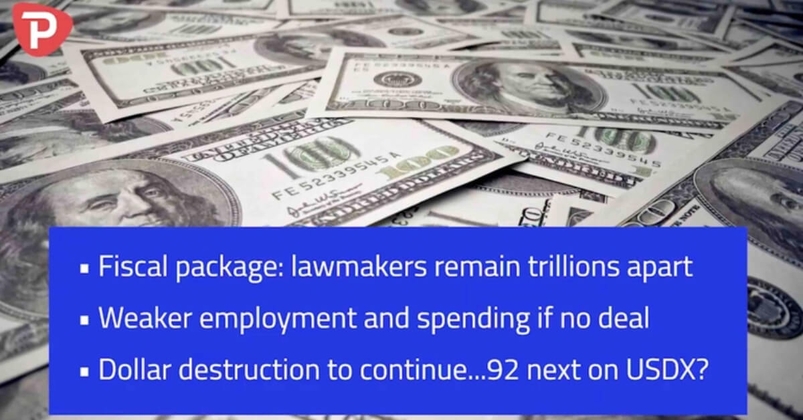- English
- Italiano
- Español
- Français
Analysis
On Friday we saw nominal bond yields up 3 to 4 basis points on US treasury 10s and 30s, yet inflation expectations fell a touch and the results were ‘real’ yields moved 4bp higher. Is this a taste of things to come?
The moves in real yield were hardly pronounced but the effect was a 70bp rally in the USD, while the NAS100 fell 1.1% and commodities were weaker. It is all one trade and if we start to see yields higher, and that is a big if, but the prospect if elevated, then what we saw on Friday may be a taste of things to come.
With this in mind, arguably the three most important instruments in markets over both the short - and medium-term are:
- US ‘real’ Treasury yield – The only game in town and the move deeper and deeper into negative territory has been the key tailwind for growth stocks (a la tech), gold/silver/crypto and the USD. Real yields reflect expectations from the Fed and have moved a long way as we gear up for a major change in policy in September to target average inflation. If this trade is to continue real yields hold the key. Any lift in real yield could see value outperform and compel USD shorts cover.
- Inflation is key - It's the one constraint that will change Fed policy, although that is a 2021 story, if not 2022. US 5 & 10-year breakevens look at average inflation expectations over a set duration. Breakeven rates have moved a long way since 19 March, but if real yields are going to head lower then we need to see inflation expectations moving higher while nominal bond yields stay anchored.
- US 5y5y forward breakevens - (5-year inflation expectations starting in five years’ time). Similar to breakevens, but they are a slower mover. We know the Fed looks at forward inflation expectations, so should these march higher than it could have big implications for markets.
White – NAS100, purple – US5yr real Treasury yield (inverted), orange – gold
(Source: Bloomberg)
Big picture drivers:
- US fiscal negotiations – While fiscal talks continue, Trump’s move to sign four executive orders should be fairly well received by the markets, even if the measures reduce some of the urgency to strike a deal. At the margin, it increases the prospect the Dem’s come closer to the Republicans fiscal proposal, and I still feel we get a deal of around $1.5t, either this week or next.
- US-China talks – Both nations hit the negotiating table on Saturday, with the discussion falling on the Phase 1 deal and China’s mandated $200b increase in imports over two years. With focus on Tiktok (and its likely suitor), and the US sanctioning Chinese tech firm, as well as HK Chief Executive Carrie Lam, it will be interesting to read the level of tension in the room. Also, consider that Huawei’s temporary license to work with US firms expires on Thursday and the prospect it won’t be rolled over is elevated.
- US politics – We should hear Joe Biden’s pick for VP early this week. Unless we see a shock appointment for Elizabeth Warren, a probability the market places at 4%, then the news of placement of Kamala Harris or Susan Rice shouldn’t move the dial too greatly. The saying goes, a good pick won’t win you an election, but a bad pick will lose you one. If I were a betting man, I like Susan Rice as value, although Harris has been the front-runner for weeks for a reason.
- Covid-19 trends – Always a consideration for the week ahead, as it all is all-encompassing – sadly, and affects everything we do in life.
- US high-frequency data – With the US payrolls out of the way, it is clear US data continues to come in better than expected. From here, the market will be watching higher frequency data where they can get it - these include restaurant bookings, flight activity, initial jobless and continued claims, credit card spending and traffic congestion statistics.
- For those trading the AUS200 - The focus will fall on FY corporate earnings, with nearly 30% of the index due to report this week. That includes FY numbers from CBA and an update from NAB.
Weekly implied volatility matrix
Monday
China – July credit data (no set date, but due any day this week) – M2 money supply (consensus 11.1%), new yuan loans (consensus RMB1.2t), aggregate financing. The market is focused more on US-China relations than China’s credit data at this stage.
Tuesday
Australia – July Nab business confidence (11:30 AEST) – there is no survey to derive consensus and unlikely a market mover, but certainly a survey the RBA is looking at quite closely. The implied low (with a 68.2% degree of confidence) in AUDUSD sits at 0.7070, which takes us to horizontal support (drawn from 10 June high) – one for buyers of dips.
UK – July jobless claims (16:00 AEST), ILO unemployment rate (consensus 4.2%), employment change 3m/3m (-298,000 jobs)
Germany – ZEW survey (expectations/current situation - 19:00 AEST) – consensus is for a decline in the ‘expectations’ survey to 55.6 (from 59.3), although these are still levels not seen for more than five years. The current situation should improve but at -69 is still deeply negative. Watching the 200-day MA on GER40, with the 12,200 swing a line in the sand. EURUSD looks supported into 1.1693/84, where a break below would see vols pick-up.
US – NFIB small business optimism (20:00 AEST) – consensus is for a small decline to 100.4 (from 100.6)
Wednesday
Australia – Westpac consumer confidence (10:30 AEST), where the risk of a shift lower is elevated due to COVID-19 restrictions in Victoria. Q2 wage price index (11:30 AEST) – the market expects to see wages increase 0.3% QoQ and 1.9% YoY
NZ - RBNZ meeting (12:00 AEST) – While the RBNZ will remain dovish, there will be no change to rates. There is scope for an increase in the banks QE program, given the rise in government bond issuance. Look out for signs the RBNZ could be heading in a similar path as the RBA by capping yields through adopting yield curve control. There is also a belief we see a positive revision to the bank’s growth forecasts. AUDNZD is eyeing key resistance into 1.0866 and a close through here opens up a move to 1.1000 – consider the influence of relative AU-NZ financial conditions.
UK – Industrial/manufacturing production (+9%MoM). We also get monthly GDP for June (consensus +8%) and the Q2 GDP aggregate print – consensus is for -20.5% QoQ, or -22.5% YoY
US – July CPI/core CPI - consensus is for headline inflation to rise 0.3%MoM (+0.7%YoY) and core 0.2% MoM (1.1%YoY). Markets are more sensitive to inflation expectations, through breakeven rates or forward-inflation rates (5y5y forward breakevens) and the impact these have on ‘real’ rates – arguably the most important variable in any markets.
Thursday
US – Fed member Rosengren discusses the US economy (00:00 AEST). Fed member Daly speaks at 05:00 AEST. Not sure we’ll learn much from either Fed member, with traders looking ahead to the July FOMC minutes (20 August) and Jackson Hole (27th August)
Australia – July employment change – the market expects 30,000 net jobs to be created (economist range +150k to -120k), with the unemployment rate due to rise to 7.8% (from 7.4%) as the participation rate increases 40bp to 64.4%. Also watching hours worked. The marquee event in Oz and holds volatility risk given the sheer dispersions in forecasting.
US – Initial jobless claims (22:30 AEST) are expected to decline modestly to 1.1m, with continuing claims also reduced to 15.8m (from 16.10m). Well worth watching given the better numbers seen last week – will these start trending lower?
Friday
Australia – RBA gov Lowe appears before the Parliament Economic Committee (09:30 AEST)
China – July industrial production (12:00 AEST - consensus 5.1%), retail sales (0.1%), fixed asset investment (-1.6%). The improvement continues, albeit at a slower pace.
US - July retail sales (22:30 AEST) – consensus is for 1.9%, down from 7.5% in June. The control group element – the basket of goods that feeds into the Q3 GDP calculation is expected at 0.8%.
US – Industrial Production (23:15 AEST) – consensus sits at 3%. University of Michigan survey (sub-surveys – sentiment, current conditions, expectations, 1 &5-10yr inflation expectations).
Related articles
Ready to trade?
It's quick and easy to get started. Apply in minutes with our simple application process.
The material provided here has not been prepared in accordance with legal requirements designed to promote the independence of investment research and as such is considered to be a marketing communication. Whilst it is not subject to any prohibition on dealing ahead of the dissemination of investment research we will not seek to take any advantage before providing it to our clients.
Pepperstone doesn’t represent that the material provided here is accurate, current or complete, and therefore shouldn’t be relied upon as such. The information, whether from a third party or not, isn’t to be considered as a recommendation; or an offer to buy or sell; or the solicitation of an offer to buy or sell any security, financial product or instrument; or to participate in any particular trading strategy. It does not take into account readers’ financial situation or investment objectives. We advise any readers of this content to seek their own advice. Without the approval of Pepperstone, reproduction or redistribution of this information isn’t permitted.


